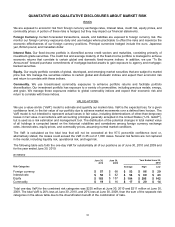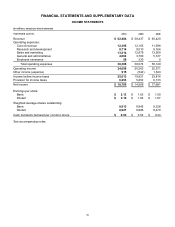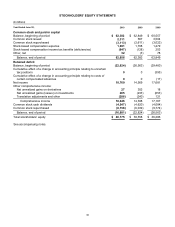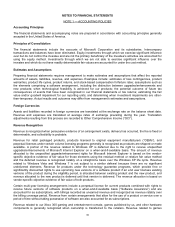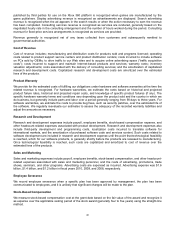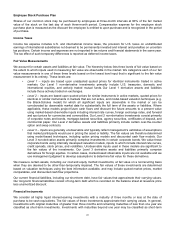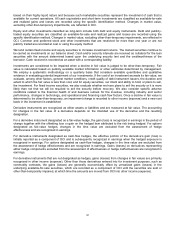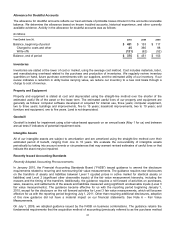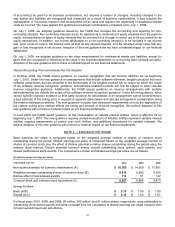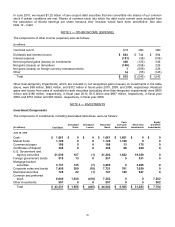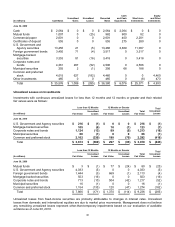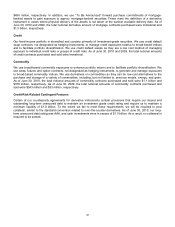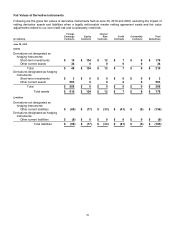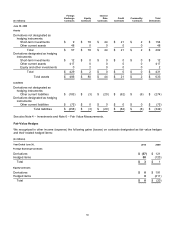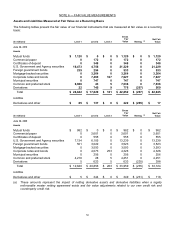Microsoft 2010 Annual Report Download - page 44
Download and view the complete annual report
Please find page 44 of the 2010 Microsoft annual report below. You can navigate through the pages in the report by either clicking on the pages listed below, or by using the keyword search tool below to find specific information within the annual report.
43
Allowance for Doubtful Accounts
The allowance for doubtful accounts reflects our best estimate of probable losses inherent in the accounts receivable
balance. We determine the allowance based on known troubled accounts, historical experience, and other currently
available evidence. Activity in the allowance for doubtful accounts was as follows:
(In millions)
Y
ear Ended June 30, 2010
2009 2008
Balance, beginning of period $ 451
$ 153 $ 117
Charged to costs and other 45
360 88
Write-offs (121 )
(62) (52)
Balance, end of period $ 375
$ 451 $ 153
Inventories
Inventories are stated at the lower of cost or market, using the average cost method. Cost includes materials, labor,
and manufacturing overhead related to the purchase and production of inventories. We regularly review inventory
quantities on hand, future purchase commitments with our suppliers, and the estimated utility of our inventory. If our
review indicates a reduction in utility below carrying value, we reduce our inventory to a new cost basis through a
charge to cost of revenue.
Property and Equipment
Property and equipment is stated at cost and depreciated using the straight-line method over the shorter of the
estimated useful life of the asset or the lease term. The estimated useful lives of our property and equipment are
generally as follows: computer software developed or acquired for internal use, three years; computer equipment,
two to three years; buildings and improvements, five to 15 years; leasehold improvements, two to 10 years; and
furniture and equipment, one to five years. Land is not depreciated.
Goodwill
Goodwill is tested for impairment using a fair-value-based approach on an annual basis (May 1 for us) and between
annual tests if indicators of potential impairment exist.
Intangible Assets
All of our intangible assets are subject to amortization and are amortized using the straight-line method over their
estimated period of benefit, ranging from one to 10 years. We evaluate the recoverability of intangible assets
periodically by taking into account events or circumstances that may warrant revised estimates of useful lives or that
indicate the asset may be impaired.
Recently Issued Accounting Standards
Recently Adopted Accounting Pronouncements
In January 2010, the Financial Accounting Standards Board (“FASB”) issued guidance to amend the disclosure
requirements related to recurring and nonrecurring fair value measurements. The guidance requires new disclosures
on the transfers of assets and liabilities between Level 1 (quoted prices in active market for identical assets or
liabilities) and Level 2 (significant other observable inputs) of the fair value measurement hierarchy, including the
reasons and the timing of the transfers. Additionally, the guidance requires a roll forward of activities on purchases,
sales, issuance, and settlements of the assets and liabilities measured using significant unobservable inputs (Level 3
fair value measurements). The guidance became effective for us with the reporting period beginning January 1,
2010, except for the disclosure on the roll forward activities for Level 3 fair value measurements, which will become
effective for us with the reporting period beginning July 1, 2011. Other than requiring additional disclosures, adoption
of this new guidance did not have a material impact on our financial statements. See Note 6 – Fair Value
Measurements.
On July 1, 2009, we adopted guidance issued by the FASB on business combinations. The guidance retains the
fundamental requirements that the acquisition method of accounting (previously referred to as the purchase method



